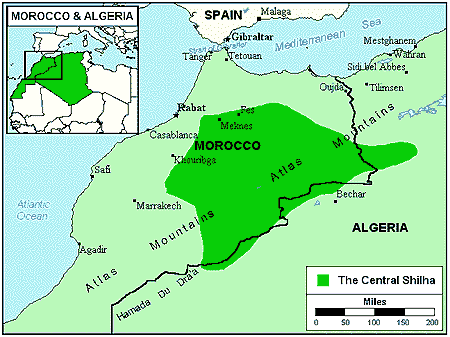|
|
Prayer Profile
Central Shilha of Algeria
![[IMAGE]](../images2/0357.jpg) The Central Shilha belong to a much larger group known as the Shilha Berbers. The Shilha are made up of three main groups of Berbers: the Northern (Rif) Berbers, the Southern (Sousi) Berbers, and the Central (Berbaber) Berbers.
The Central Shilha belong to a much larger group known as the Shilha Berbers. The Shilha are made up of three main groups of Berbers: the Northern (Rif) Berbers, the Southern (Sousi) Berbers, and the Central (Berbaber) Berbers.
The Central Shilha live primarily in the beautiful, wooded High Atlas and Middle Atlas Mountains of Central Morocco. However, a large number of them also live on the slopes of the Atlas mountains in eastern Algeria, near Morocco's border. All of the Berabers speak Tamazight; however, many also speak Arabic, Algeria's official language.
The Central Shilha are semi-nomadic shepherds. In the mountains, raising animals is economically more important than farming. The dominant feature of Beraber life is transhumance. This means that they transfer their livestock from one grazing ground to another, alternating from the highlands to the lowlands, with the changing of seasons.
What Are Their Lives Like?
The Central Shilha primarily raise sheep and goats, although other domestic animals are also kept. Most have a few mules and donkeys, which are used for transport. Only one tribe, the Zain, raises large herds of cattle.
The Central Shilha move their herds to the warm plains during the winter months, then to higher pastures during the spring and summer months. Depending on their locations in the mountains, some of the tribes only have to move their herds during the winter. Others only migrate during the summer. A third group moves the herds during the winter and the summer.
Although often on the move, none of the tribes are totally nomadic. All of them maintain permanent villages with fortified, community granaries and surrounding farmlands. The villages are never left unattended. A small number of people stay behind to guard the granaries and to plant crops such as barley, maize, wheat, rye, millet, and vegetables.
Many Central Shilha villages are found among the highest hills and are often built partially into the mountainsides. Very few villages have electricity or running water, but most have their own internal means of communication.
Among the Central Shilha, it is common for three or four generations to live in the same dwelling. All of the family members acknowledge a common male ancestor. As members of the family, they are entitled to certain rights and privileges concerning the family heritage.. The family structure is somewhat of an authoritarian democracy. While the head of the family is responsible for controlling and administering all household matters, he must come to an agreement with the rest of the family. Banishment from the family is considered the ultimate punishment
What Are Their Beliefs?
The Central Shilha are 99.9% Muslim; however, their religious practices are based more on traditions and the decisions of the community judges than on the Koran. Their societies are organized around two main systems: Islam and the tribe. However, there are many differences between urban and rural societies. In urban areas, orthodox Islam prevails; whereas, in rural societies, ancient beliefs and customs are intermingled with their Muslim faith.
Most of the Central Shilha have continued in their traditional worship of saints. One group of spiritual leaders called marabouts is considered "living saints." They are believed to possess healing abilities and supernatural powers. Each of the villages reveres one or more of these "saints."
What Are Their Needs?
In the eighth century, invading Arabs forced the Berabers to accept Islam. However, prior to that time, many of them were Christians. Unfortunately, there are only 204 known Central Shilha believers in Algeria today. Additional laborers and tools such as Christian broadcasts are needed to help these precious people return to the God of their forefathers.
Prayer Points
- Ask God to grant wisdom and favor to the missions agencies that are currently working among the Central Shilha.
- Ask the Lord to raise up additional long-term workers who are sensitive to the Muslim culture.
- Pray for God to anoint the Gospel as it goes forth via radio to the Central Shilha.
- Ask the Lord to encourage and protect the 204 known Central Shilha believers in Algeria.
- Take authority over the principalities and powers that are keeping the Central Shilha bound in spiritual darkness.
- Ask God to call forth prayer teams who will begin breaking up the soil through worship and intercession.
- Ask God to reveal Himself to the Central Shilha through dreams and visions.
- Pray that strong local churches will be raised up among the Central Shilha.

See also the following Groups:
The Saharan Berbers;
The Riff Berbers of Morocco,
Algeria, and
France;
The Central Shilhah of Morocco,
and the Berbaber of France;
The Southern Shilhah of Algeria and
Morocco;
The Kabyle Berbers of Algeria,
Belgium, and
France;
Statistics
Latest estimates from the World Evangelization Research Center.
THE PEOPLE
- People name: Central Shilha
- Country: Algeria
- Their language: Tamazight
- Population:
- Largest religion:
- Christians: <1%
- Church members: 204
- Scriptures in their own language: Portions
- Jesus Film in their own language: Available
- Christian broadcasts in their own language: Available
- Mission agencies working among this people: 2
- Persons who have heard the Gospel: 295,900 (29%)
- Persons who have never heard the Gospel: 723,900 (71%)
THEIR COUNTRY
- Country: Algeria
- Population:
- Major peoples in size order:
- Major religions:
- Number of denominations: 23
© Copyright 1997
Bethany World Prayer Center
This profile may be copied and distributed without obtaining permission
as long as it is not altered, bound, published
or used for profit purposes.
![[HOME BUTTON]](../graphics/home.jpg)
![[CALENDAR BUTTON]](../graphics/calico.jpg)
![[LIST BUTTON]](../graphics/listico.jpg)
[Home]
[Calendar]
[Country List]
|